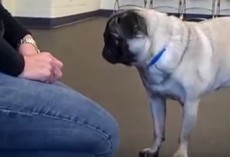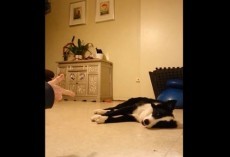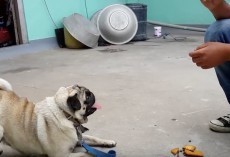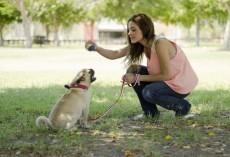Check out these common behaviors. Are you doing something that might be perpetuating your pup’s bad conduct?
1. Potty Accidents. There’s really nothing worse than walking into a room and stepping in a giant puddle your puppy has left for you. It’s even worse when it’s not liquid that you step into, but did you know that the puddle (or pile) on the floor is less likely to be the dog’s fault, and more likely to be your own? Sure, a dog or puppy is suppose to let you know when they need to go out, but how do you think they learn that behavior. That’s right! You have to teach them. A puppy-in-training should never have free roam of the house, and they should be constantly watched. If you catch your pup peeing, it’s too late. Dog’s do not have the ability to stop mid-stream, so it’s best to schedule potty breaks every so often, as well as taking your dog out after a meal. Never go for more than a few hours without giving your dog the chance to do his business outside.
2. Nipping. Everyone finds it adorable to have a small puppy chew on their finger, but that cute little game can soon turn into a complete nightmare. By teaching your puppy that biting=playing, you are essentially telling them that it is not only okay to nip and bite, but that it is actually encouraged for them to do so. There’s no real good way to fix this problem once the behavior is learned. Start off by not allowing your puppy near human skin in the first place, especially near little fingers or toes. Don’t rough house with your dog, and they won’t try to rough house when it is unwanted.
3. Chewing. Your kid comes to you with a half-chewed Batman figure, or maybe a chewed up duplo block, and you tell them they shouldn’t have left their toys on the floor for the dog to pick up and chew. Now, rewind back to 30 minutes ago when you were carrying on about your favorite pair of shoes being chewed up. Or your work boots. You had it right when you were talking to your kid: You shouldn’t have left them in the floor! To a dog, especially a young pup, anything within reach is fair game. If you leave something on the floor while your pup is still learning to only chew on bones, you are going to have a rough time. Keep your stuff out of reach of the pup, and vice versa, and be sure to switch out anything you see being chewed on for a bone or chew toy.
4. Destroying the house while you’re out. Dogs are just like people. They have needs, feelings, and emotions. One of these is anxiety, and when they are home alone, many dogs suffer from separation anxiety. Just as a child throws a fit when it wants something, but does not know how to say it, so does a dog. This may lead to torn pillows, destroyed cloth, or even to your dog using the bathroom on your couch, floor, or bed. This really isn’t your dog’s fault. If you are giving a big farewell to your dog, and making it into a big thing, you dog is going to feel like it is a big thing, and it can and will cause your dog to become very anxious. Instead, simply walk out the door. If you must say bye, quickly say it, and leave. The less dramatic you make it, the less dramatic your dog will make it.
5. Barking, snapping, and/or growling at you or family members. Here it is very important to remember that dogs are pack animals. You have to let your dog know that you are the leader of the pack, otherwise, it may very well start to growl at you when you touch its toy, or sit too close to it when it doesn’t want. While some breeds are known to be more dominantly aggressive, chances are that your dog is acting this way because of something you did or didn’t do. It usually isn’t just one action that makes a dog think that it is the leader; it’s actually usually a lot of things. If your dog barks, maybe you give him his toy, or you feed him exactly when he wants to be fed, or you let him go where he wants without any restrictions. All of these things can lead to a dog forming the idea that he is the leader. How do you take back your rightful spot on pride rock? Don’t give your dog what he wants. If your dog wants to be fed or given a treat, hold the food/treat until your dog stops whining or barking. Once they give up and are no longer being demanding, give them the treat. Restrict your dog’s access to certain spots in the house. “Claim” them as your own. Doing this tells your dog that you make the decisions, and therefore, you wear the paws in the relationship.
6. Excessive barking. How many times has little FooFoo been outside, barking her head off? When you call her to come in, do you call for her all sweet-like? Do you entice her with a treat? Maybe you squeak her favorite toy to get her back in the house? Do you know what you just taught little FooFoo? You taught her that if she barks like a maniac, she gets love, attention, and maybe even a toy or treat. So, how do you get FooFoo to stop barking? Go outside with a treat, or even stand at the door. While your dog is barking, ignore him/her. Once they come over and stop barking, give them the treat. If your dog is good with “quiet” or “no,” then you can use those commands to get your dog to stop barking, and then give the treat. Just make sure you are reinforcing the proper behavior.
When a pet-owner starts to train or retrain, while figuring out the mistakes of the past, there is no end to the thrills and excitement of accomplishment.
Finally, “Fido” isn’t piddling on the kitchen floor or “Spot” isn’t jumping up on Mrs. Jones when the poor woman comes to the door for a visit.
To see more things you may be doing incorrectly with your precious pooch please go to Dog Tube. Tis website addresses topics like car sickness, pulling on the dog leash and the ever comical but often uncomfortable HUGE lapdog!











Kellie Hutchins
- Edit
Seth Lanchak